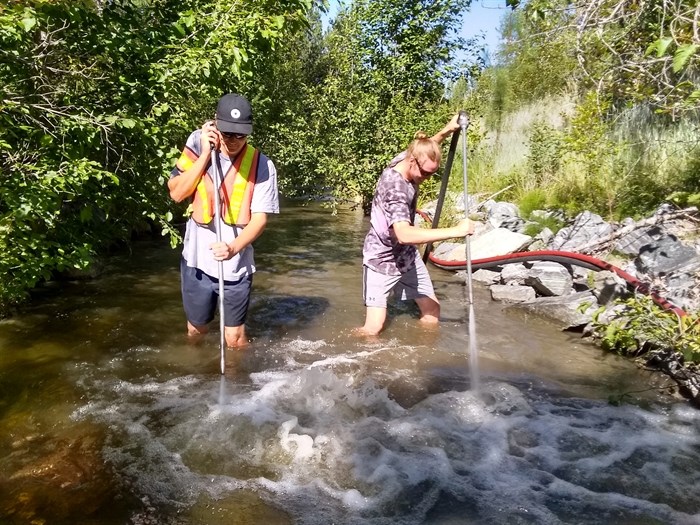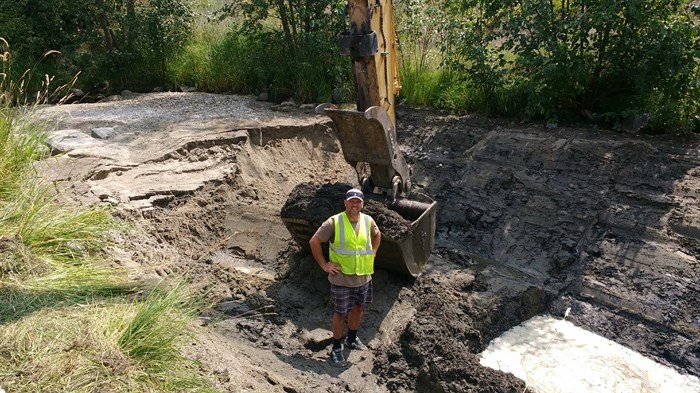
Every year crews use high pressure washers to clean the gravel in the Mission Creek spawning channl.
Image Credit: Submitted/Ministry of Forests
August 18, 2020 - 7:00 AM
It’s been decades since the kokanee population crashed in Okanagan Lake.
While major projects like the Mission Creek spawning channel are keeping the species alive, they’ve yet to come near to historical population levels.
“The population has gone up and its gone down,” Tara White, Senior Fisheries Biologist with the Ministry of Forests, told iNFOnews. ca. “We have seen a slow increasing trend. It’s not fabulous.”
There was a time when an estimated 10 million of the land-locked salmon lived in the lake and more than one million would spawn in the many kilometres of spawning beds in Mission Creek – the main supplier of water and spawning areas for Okanagan Lake.
Back in its early, more natural days, Mission Creek would flood huge areas of what is now Kelowna, cutting various channels through the flatter lands near the lake after pouring out of the hills through Gallagher’s Canyon.
Residents got fed up with the uncontrolled flooding so the creek was confined by dikes in the 1950s, which was the beginning of the collapse of Kokanee populations.
It was in the 1960s that the next major blunder was committed with the introduction of two milk jugs full of mysis shrimp that were meant to provide a food source for the kokanee. It had the opposite effect as the shrimp outcompeted the kokanee.
"The fish spend most of their time deeper down during the night and come to the surface during the day, and the mysis tend to go down during the day and come to the surface at night,” TRU ecologist Dr. Brian Heise told iNFOnews.ca.
READ MORE: Invasive shrimp in Okanagan Lake still an issue after 50 years
Then there were the impacts of development and nutrient imbalances to add pressure to the dwindling kokanee population.
Corrective action started in the 1980s with the construction of a 900-metre long spawning channel in Mission Creek Regional Park.
“Kokanee stocks crashed in the early 90s and dropped down to like 10,000 fish,” White said. “We closed the recreation fishery and started recovery efforts.”
Part of that effort requires dump trucks and pressure washers.
There is a settling pond at the top of the spawning channel where much of the sediment from the spring runoff settles out before flowing over the gravel in the spawning channel.

This year 16 dump truck loads of sediment were hauled out of the Mission Creek settling pond.
Image Credit: Submitted/Ministry of Forests
Each summer, about a dozen dump truck loads of muck are hauled out of that pond. This year there were 16 truck loads but the record was in 2018 where spring floods dumped 30 truck loads into the pond.
Then crews take power washers to clean the sediment out of the gravel so eggs are able to survive the winter. If there is too much sediment, it compacts in the gravel, not allowing enough water to flow around the eggs. That allows a fungus to grow and kill those eggs.
That work can cost $15,000 to $20,000 a year but seems to be paying off.
About 20 per cent of Okanagan Lake’s kokanee spawn in streams, with Mission Creek hosting the vast majority. About one-third of those use the spawning channel.
Last year that amounted to 11,767 fish, leaving behind 3.1 million eggs, of which 1.2 million (38 per cent) survived. That compares favourably to the six per cent survival rate in the wild but well down from the best year on record at 60 per cent.
Another key spawning area is between Casorso Road and Gordon Drive. That’s why, when the spawning channel is being hosed down, that sediment is trapped in a lower pond so it doesn’t flow downstream to clog up the natural spawning area.
The kokanee hatched in Mission Creek are distinct from the shore spawners. For one thing, they’re much bigger. They’re in the 30 to 40 cm range compared to closer to 20 cm for the shore spawners that make up the vast majority of kokanee in the lake.
Still, populations are far from their peak.
There are 250,000 to 300,000 kokanee that spawn each year, with 80 per cent being shore spawners. Since they spawn, on average, every four years, that means there may be around one million kokanee in Okanagan Lake, about a tenth of what there used to be.

Pumping out the settling pond.
Image Credit: Submitted/Ministry of Forests
But, there is more to keeping the stream spawner survival rates up than washing some gravel. Water levels are crucial, White said.
“That is the biggest bottleneck to stock production in the Okanagan region,” White said. “High water temperature and low flow.”
That means keeping upper elevation reservoirs full enough to allow for water to be released into the creek as the fish start massing in late August before moving up the creek to spawn in September.
The upper level water release also helps cool the natural flowing creek water.
A more recent improvement has been the creek restoration project between Casorso Road and Gordon Drive. That pushed back the dike back along 475 metres of the creek, with work completed in 2016 in an effort to minimize damage to the spawning areas.
“The goal of the restoration project was to set back the dikes and to create a more semi-natural area and flood plain area, in order to reduce that flood of freshet flows,” White said. “The other intent of setting back the dike was to provide some settling area for the sediment to settle out so it’s not settling out in the key gravels and spawning area.”
Other benefits included habitat improvements for plants and species at risk. It created some deeper pools so, when the kokanee come up the creek, they have some resting areas rather than pushing straight through in shallow water.
The project will be formally reviewed next year with the idea of moving to a second area some time in the future but that can be costly, especially if land needs to be bought.
The restoration has also created good rearing habitat for a species of fish that spawn in the creek but most people don’t see or think about — rainbow trout.
There’s not much known about the number of rainbow trout that spawn in Mission Creek because, rather than struggle upstream through the shallow waters in the fall, they push against the flood waters in the spring.
“There’s the smaller, average rainbow size that most of us catch that utilize Mission Creek,” White said. “Then there’s a genetically distinct large-bodied stock which are those 16 to 20 pound fish that are targeted in the recreational fishery. Those guys spawn up by Gallagher’s Canyon.”
The Ministry has tried to count those fish but a fish-counting fence was blown out by the water. Visibility is minimal because of the sediment being carried downstream.
The power washing and dump truck work finished last week. The kokanee are getting ready to head upstream. Their peak spawning time is usually in the third week of September.
To contact a reporter for this story, email Rob Munro or call 250-808-0143 or email the editor. You can also submit photos, videos or news tips to the newsroom and be entered to win a monthly prize draw.
We welcome your comments and opinions on our stories but play nice. We won't censor or delete comments unless they contain off-topic statements or links, unnecessary vulgarity, false facts, spam or obviously fake profiles. If you have any concerns about what you see in comments, email the editor in the link above.
News from © iNFOnews, 2020